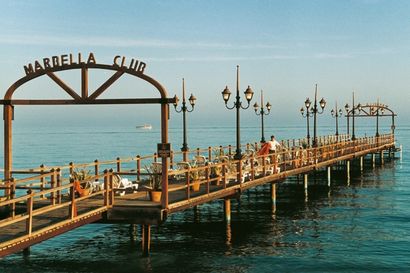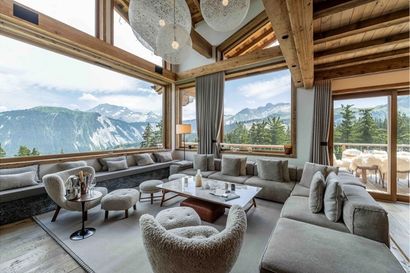There’s lots of talk about Lisbon. Perhaps too much talk, really. In the past five years, Portugal’s capital has fast become the number one city break destination, offering up some of the greatest hotels, restaurants, bars and galleries in Europe. And, as though it were the set of a Wes Anderson film, it draws in travellers with its pastel-hued buildings and lovely wooden trams that crawl up the city’s seven hillsides.
Part vibrant capital, part port, its location on the banks of the Tagus is spectacular. Once a remote outpost on what was thought to be the end of the known world, Lisbon had established itself as a centre of exploration by the 15th century. In the final embers of the Portuguese Empire, the new city we see today emerged, especially because of the efforts made in the build-up to being designated a European City of Culture in 1994 and ahead of hosting Expo ’98.

Image: Getty
Today, Lisbon is like a European San Francisco, and not just because of its near-identical 25 de Abril suspension bridge. It’s the city where hills, trams and traffic blend seamlessly with the sound of seagulls and ships’ fog horns. In this sense, Lisbon still encapsulates the excitement of its foundations. And though the downsides of that are the hordes of Canon-toting tourists and mobbed hotspots, it’s still possible to escape the masses and make for the lesser-known highlights. It just requires a bit of insider knowledge.
The hotel to book
Like a grand London townhouse, the staircase to Hotel Valverde rises from the street, offering up some much-needed respite from Lisbon’s activity. Part of the Relais & Châteaux collection of hotels, this boutique stay is located under ten minutes away by taxi from the airport and a short distance from the main train stations. Set back from the busy, tree-lined 19th-century Avenida da Liberdade, the city’s spirited main boulevard, Valverde is nestled among some of the biggest names in fashion and design, yet remains reassuringly authentic and down-home.


The townhouse feel continues inside with bursts of Portuguese art and design here and there, giving some local flavour. In 2021, it extended into the property next door, adding a further 26 rooms (there are 48 in total), all varying in size and shape owing to the main building’s age and heritage. There’s a cosy interior finish and comfortable beds, and the black-and-white bathrooms add a sophisticated touch.
With young, friendly and accommodating local staff, there’s seldom a task they can’t help with, be it entertaining boisterous children during check-in or fixing up a cocktail at the end of your hot day scaling the city’s seven hills. Best of all is a heated swimming pool, hidden behind the trees and bushes in the central courtyard around which the hotel wraps itself.
How to fill your itinerary
Walk long enough in Lisbon and you’ll quickly gravitate towards the cool of the Tagus Estuary. Here, the wind whips down the waterside as ships and, occasionally, dolphins ride the waves out to sea or back into port.

The Museum of Art, Architecture and Technology
Along the water sits some of the city’s best sights, including the well-known (and visited) Belém Tower. Built between 1514 and 1520 by the Portuguese architect and sculptor Francisco de Arruda, the imposing structure rises from the waves and was classified as a UNESCO World Heritage Site in 1983. The elaborately decorated construct was initially used to defend the city beforeit was transformed into a lighthouse and customs house. Even though it’s now a tourist trap, it’s still worth a walk down the waterside to get a glimpse of this unusual architectural triumph.
Additionally, we recommend you drop into The Museum of Art, Architecture and Technology (MAAT), another stunning masterstroke – albeit at the opposite end of the spectrum to the Belém Tower – with its organic flow of lines.
Away from the water and up in the hills sits the Jardim Botânico de Lisboa, the city’s botanical gardens – take some time wandering around and soaking up the amazing trees and endangered plant species from all around the world. As with most of Lisbon, it’s located on a hillside with cobbled paths – it can be quite a workout.

Image: Getty
Aside from the above, the city is best seen by foot, although you should take a moment to squeeze yourself into one of the many trams, which reduce their passengers to sardines for a short while. That said, they take the sting out of the steepest hills, so it’s worth the crush. But tram or no tram, make sure to get up high and embrace all of the many viewpoints, or ‘miradouros’. They’re well worth the walk and workout, particularly when there’s a superlative cocktail bar next door, such as at Miradouro da Senhora do Monte and Miradouro da Penha de França.
Where to eat

Sítio
Though Bonjardim is located on a little street off Avenida da Liberdade, it’s still thick with character and is a favourite among locals looking for a quick and tasty feed. Chicken grilled over charcoal is the dish of the day, every day. Sure, there are other items on the menu, but Bonjardim is the self-styled ‘King of Chicken’, so stick with that. No frills, full of locals – just note that it prides itself on quick covers, so don’t expect to hang around.
For something a little more sophisticated, head north, a little way up Avenida da Liberdade, to find Sítio, one of the city’s best-kept secrets located in the Valverde hotel. Escape the evening heat with a cocktail in the leafy green courtyard before heading into the intimate, 30-seat restaurant that’s complete with a colourful tiled floor and delicate wooden dividers that nod to Lisbon’s Moorish heritage. As for the food, chef Bruno Caetano Oliverira offers dishes focused on Portuguese delicacies, such as Bísaro pork tenderloin and sautéed prawns.
If seeking a back-to-basics lunch, head to Sol e Pesca, in close proximity to the old docks. This long-and-little slice of a lively pedestrianised street is located next to busy bars and has barely changed since its life as a store for fishing equipment. Sticking to its original name – meaning ‘Sun and Fishing’ – and décor, it now specialises in canned fish (sardines on toast bathed in olive oil; crispy bread with tuna and tomato) with well-priced beer or a glass of wine.
Then, grab something sweet – it’s well worth the walk up to Nannarella, even if the queues are around the block. Hold out and squeeze into this tastefully decorated gelateria serving some of the most divine ice cream, the intention of which is to bring Italian homemade food to the Portuguese capital.
Past the stunning Jerónimos Monastery lies Pastéis de Belém, one of the oldest and best-loved bakeries serving up fresh pastel de natas. It’s busy, but service is quick if you take one away to eat in the nearby park.
Finally, if needing caffeine refuels, try Fable and sit for a moment or two while you enjoy their pastries with a book from their well-curated selection of English texts.
Want more travel content? Here’s how to eat your way across the Italian Riviera without leaving home…

Become a Gentleman’s Journal Member?
Like the Gentleman’s Journal? Why not join the Clubhouse, a special kind of private club where members receive offers and experiences from hand-picked, premium brands. You will also receive invites to exclusive events, the quarterly print magazine delivered directly to your door and your own membership card.


